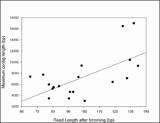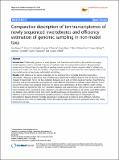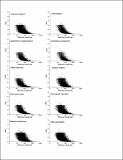Por favor, use este identificador para citar o enlazar a este item:
http://hdl.handle.net/10261/63812COMPARTIR / EXPORTAR:
 SHARE SHARE
 CORE
BASE CORE
BASE
|
|
| Visualizar otros formatos: MARC | Dublin Core | RDF | ORE | MODS | METS | DIDL | DATACITE | |

| Título: | Comparative description of ten transcriptomes of newly sequenced invertebrates and efficiency estimation of genomic sampling in non-model taxa |
Autor: | Riesgo Gil, Ana ; Andrade, Sónia C. S.; Sharma, Prashant P.; Novo, Marta; Pérez-Porro, Alicia R. CSIC ORCID; Vahtera, Varpu; González, Vanessa L.; Kawauchi, Gisele Y.; Giribet, Gonzalo | Fecha de publicación: | 29-nov-2012 | Editor: | BioMed Central | Citación: | Frontiers in Zoology. 29;9(1):33 (2012) | Resumen: | Abstract Introduction Traditionally, genomic or transcriptomic data have been restricted to a few model or emerging model organisms, and to a handful of species of medical and/or environmental importance. Next-generation sequencing techniques have the capability of yielding massive amounts of gene sequence data for virtually any species at a modest cost. Here we provide a comparative analysis of de novo assembled transcriptomic data for ten non-model species of previously understudied animal taxa. Results cDNA libraries of ten species belonging to five animal phyla (2 Annelida [including Sipuncula], 2 Arthropoda, 2 Mollusca, 2 Nemertea, and 2 Porifera) were sequenced in different batches with an Illumina Genome Analyzer II (read length 100 or 150 bp), rendering between ca. 25 and 52 million reads per species. Read thinning, trimming, and de novo assembly were performed under different parameters to optimize output. Between 67,423 and 207,559 contigs were obtained across the ten species, post-optimization. Of those, 9,069 to 25,681 contigs retrieved blast hits against the NCBI non-redundant database, and approximately 50% of these were assigned with Gene Ontology terms, covering all major categories, and with similar percentages in all species. Local blasts against our datasets, using selected genes from major signaling pathways and housekeeping genes, revealed high efficiency in gene recovery compared to available genomes of closely related species. Intriguingly, our transcriptomic datasets detected multiple paralogues in all phyla and in nearly all gene pathways, including housekeeping genes that are traditionally used in phylogenetic applications for their purported single-copy nature. Conclusions We generated the first study of comparative transcriptomics across multiple animal phyla (comparing two species per phylum in most cases), established the first Illumina-based transcriptomic datasets for sponge, nemertean, and sipunculan species, and generated a tractable catalogue of annotated genes (or gene fragments) and protein families for ten newly sequenced non-model organisms, some of commercial importance (i.e., Octopus vulgaris). These comprehensive sets of genes can be readily used for phylogenetic analysis, gene expression profiling, developmental analysis, and can also be a powerful resource for gene discovery. The characterization of the transcriptomes of such a diverse array of animal species permitted the comparison of sequencing depth, functional annotation, and efficiency of genomic sampling using the same pipelines, which proved to be similar for all considered species. In addition, the datasets revealed their potential as a resource for paralogue detection, a recurrent concern in various aspects of biological inquiry, including phylogenetics, molecular evolution, development, and cellular biochemistry. | Versión del editor: | http://dx.doi.org/10.1186/1742-9994-9-33 | URI: | http://hdl.handle.net/10261/63812 | DOI: | 10.1186/1742-9994-9-33 |
| Aparece en las colecciones: | (CEAB) Artículos |
Ficheros en este ítem:
| Fichero | Descripción | Tamaño | Formato | |
|---|---|---|---|---|
| 1742-9994-9-33.xml | 229,93 kB | XML | Visualizar/Abrir | |
| 1742-9994-9-33-S3.PDF | 67,67 kB | Adobe PDF |  Visualizar/Abrir | |
| 1742-9994-9-33-S2.XLSX | 15,31 kB | Microsoft Excel XML | Visualizar/Abrir | |
| 1742-9994-9-33-S6.XLSX | 9,57 kB | Microsoft Excel XML | Visualizar/Abrir | |
| 1742-9994-9-33-S10.XLSX | 12,6 kB | Microsoft Excel XML | Visualizar/Abrir | |
| 1742-9994-9-33-S1.XLSX | 45,75 kB | Microsoft Excel XML | Visualizar/Abrir | |
| 1742-9994-9-33-S7.PDF | 627,25 kB | Adobe PDF |  Visualizar/Abrir | |
| 1742-9994-9-33.pdf | 2,92 MB | Adobe PDF |  Visualizar/Abrir | |
| 1742-9994-9-33-S8.XLSX | 12,93 kB | Microsoft Excel XML | Visualizar/Abrir | |
| 1742-9994-9-33-S4.PDF | 12,53 kB | Adobe PDF | Visualizar/Abrir | |
| 1742-9994-9-33-S9.PDF | 382,35 kB | Adobe PDF |  Visualizar/Abrir | |
| 1742-9994-9-33-S5.PDF | 812,69 kB | Adobe PDF |  Visualizar/Abrir |
CORE Recommender
PubMed Central
Citations
49
checked on 20-abr-2024
SCOPUSTM
Citations
105
checked on 17-abr-2024
WEB OF SCIENCETM
Citations
104
checked on 27-feb-2024
Page view(s)
312
checked on 23-abr-2024
Download(s)
964
checked on 23-abr-2024
Google ScholarTM
Check
Altmetric
Altmetric
Artículos relacionados:
NOTA: Los ítems de Digital.CSIC están protegidos por copyright, con todos los derechos reservados, a menos que se indique lo contrario.
